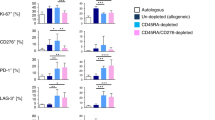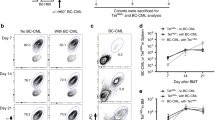Abstract
THE major barrier to replacement therapy in various clinical immunodeficiency states is the likelihood that the transferred immunocompetent T lymphocytes would react against alloantigens of the recipient and produce graft-versus-host (GVH) disease1. The logical resolution of this problem would be to delete or inactivate those clones of T cells which are specifically coded to react against the histocompatibility antigens of the recipient tissues. The remaining cell population could then fully reconstitute the recipient without danger of GVH reactions. Specific clonal deletion of this kind has been obtained in experimental animal situations by pre-circulation through a third-party host2,3 or by induction of specific anti-idiotype immunity4. These studies show the validity of this approach but are technically complicated and have limited application. A simpler method of obtaining this result has been sought based on the following strategy. To reconstitute a strain A mouse by transfer of lymphocytes from an allogeneic strain B, the strain B lymphocytes are first incubated on a monolayer of cells of strain A. Those clones which recognise the strain A alloantigens should adhere to the monolayer; the non-adherent populations of cells should now be unable to react against alloantigens of strain A but should still respond to alloantigens of other haplotypes. Although this kind of technique has been widely effective in removing fully activated cytotoxic lymphocytes (Tc)5–9, its use to deplete alloreactive Tc precursors has given variable results8,10–16. Significant depletion of precursors has been reported primarily when the non-adherent cells have been assayed in vivo13–16, but this has been claimed to be due to change in the responder cells, not depletion, as the same population assayed by in vitro generation of Tc shows no evidence of depletion16. We present here a simple depletion method developed from our finding that when splenic lymphocytes are incubated for a few hours before being formed into a monolayer, they can effectively absorb alloreactive Tc precursors even when assayed by the sensitive in vitro assays.
This is a preview of subscription content, access via your institution
Access options
Subscribe to this journal
Receive 51 print issues and online access
$199.00 per year
only $3.90 per issue
Buy this article
- Purchase on Springer Link
- Instant access to full article PDF
Prices may be subject to local taxes which are calculated during checkout
Similar content being viewed by others
References
Grebe, S. C. & Streilein, J. W. Adv. Immun. 22, 119–221 (1976).
Ford, W. L. & Atkins, R. C. Nature new Biol. 234, 178–180 (1971).
Bennink, J. R. & Doherty, P. C. J. exp. Med. 148, 128–135 (1978).
Binz, H. & Wigzell, H. Nature 262, 294–295 (1976).
Berke, G. & Levey, R. H. J. exp. Med. 135, 972–984 (1972).
Stulting, R. D. & Berke, G. J. exp. Med. 137, 932–942 (1973).
Kedar, E., Ortiz de Landazuri, M., Bonavida, B. & Fahey, J. L. J. immun. Meth. 5, 97–102 (1974).
Neefe, J. R. & Sachs, D. H. J. exp. Med. 144, 996–1008 (1976).
Chisholm, P. M. & Ford, W. L. Eur. J. Immun. 8, 438–445 (1978).
Clark, W. & Kimura, A. Nature new Biol. 235, 236–237 (1972).
Altman, A., Cohen, I. R. & Feldman, M. Cell Immun. 7, 134–142 (1973).
Bach, F. H. et al. Science 180, 403–406 (1973).
Lonai, P., Eliraz, A., Wekerle, H. & Feldman, M. Transplantation 15, 368–374 (1973).
Bonavida, B. & Kedar, E. Nature 249, 658–659 (1974).
Mage, M. G. & McHugh, L. L. J. Immun. 115, 911–913 (1975).
Kedar, E., Clark, W. R. & Bonavida, B. Transplantation 25, 146–151 (1978).
Bach, F. H., Bach, M. L. & Sondel, P. M. Nature 259, 273–281 (1976).
Leben, M. L. & Boyle, W. Transplantation 24, 201–210 (1977).
Schnagl, H. Y. & Boyle, W. J. immun. Meth. 24, 79–88 (1978).
Smart, I. J., Boyle, W. & Morris, P. J. Tissue Antigens 11, 20–29 (1978).
Janeway, C. A., Wigzell, H. & Binz, H. Scand. J. Immun. 5, 993–1001 (1976).
Bach, F. H. et al. Cold Spring Harb. Symp. quant. Biol. 41, 429–441 (1976).
Lafferty, K. J. & Woolnough, J. Immun. Rev. 35, 231–262 (1977).
Boyle, W., Kelso, A. & Leben, M. L. Nouv. Rev. Hemat. (in the press).
Author information
Authors and Affiliations
Rights and permissions
About this article
Cite this article
SCHNAGL, H., BOYLE, W. Specific depletion of alloreactive cytotoxic lymphocyte precursors. Nature 279, 331–333 (1979). https://doi.org/10.1038/279331a0
Received:
Accepted:
Issue Date:
DOI: https://doi.org/10.1038/279331a0
This article is cited by
-
Comparative study of conditions for demonstrating receptors of memory T cells and other T lymphocyte subpopulations immune to antigens of the H-2 complex
Bulletin of Experimental Biology and Medicine (1984)
-
Binding of MLR precursors requires immunosorbents which present both self- and alloantigen
Nature (1981)
Comments
By submitting a comment you agree to abide by our Terms and Community Guidelines. If you find something abusive or that does not comply with our terms or guidelines please flag it as inappropriate.



